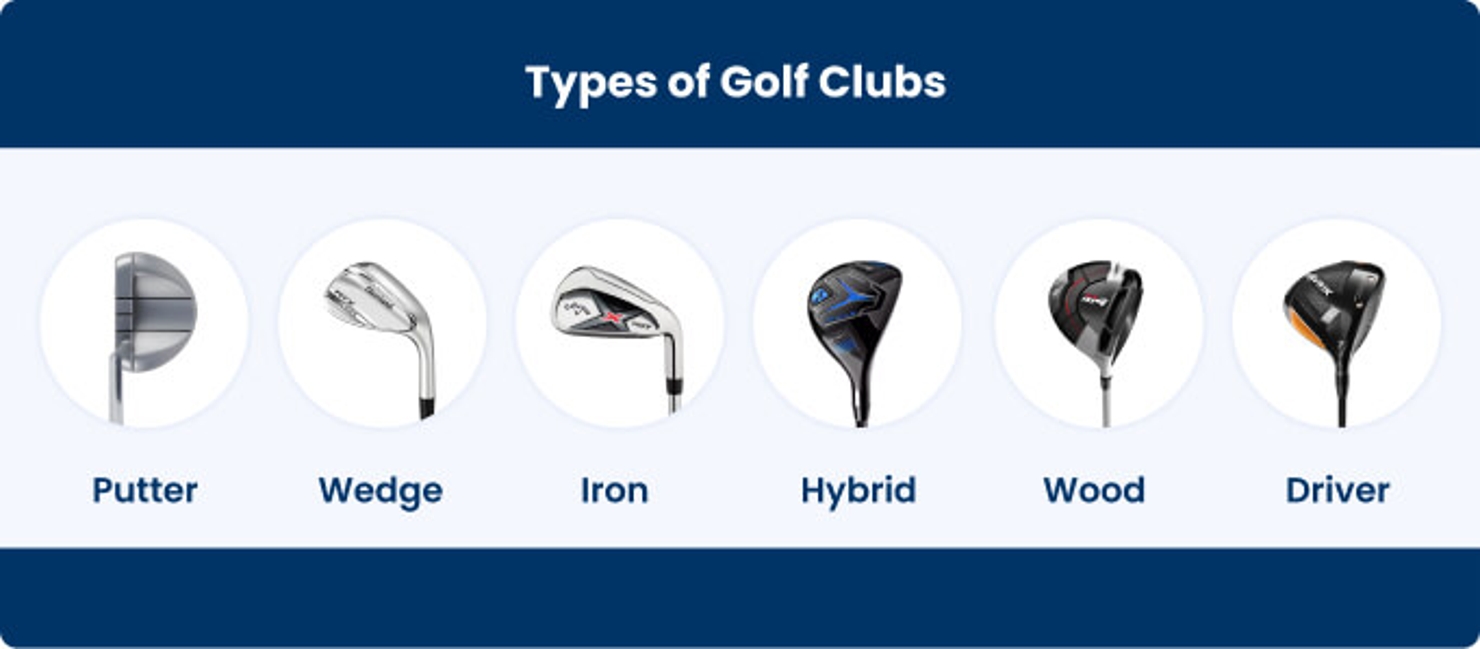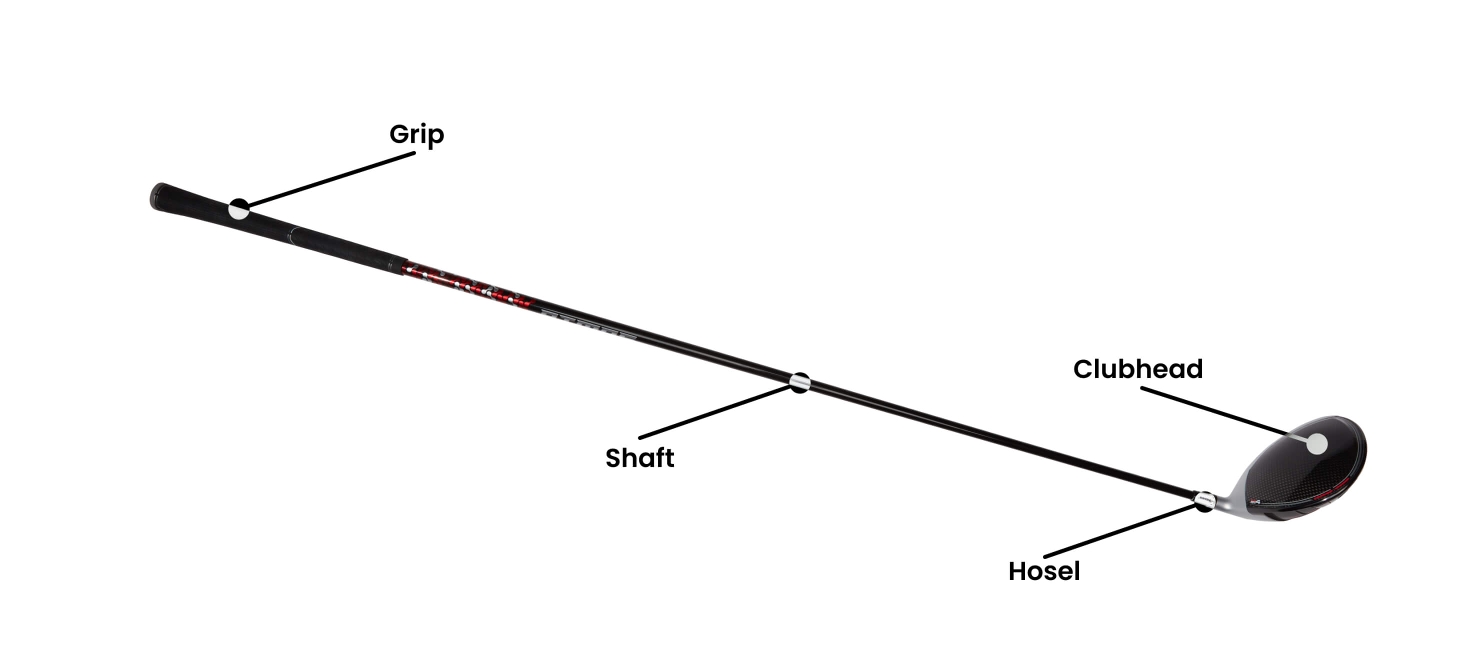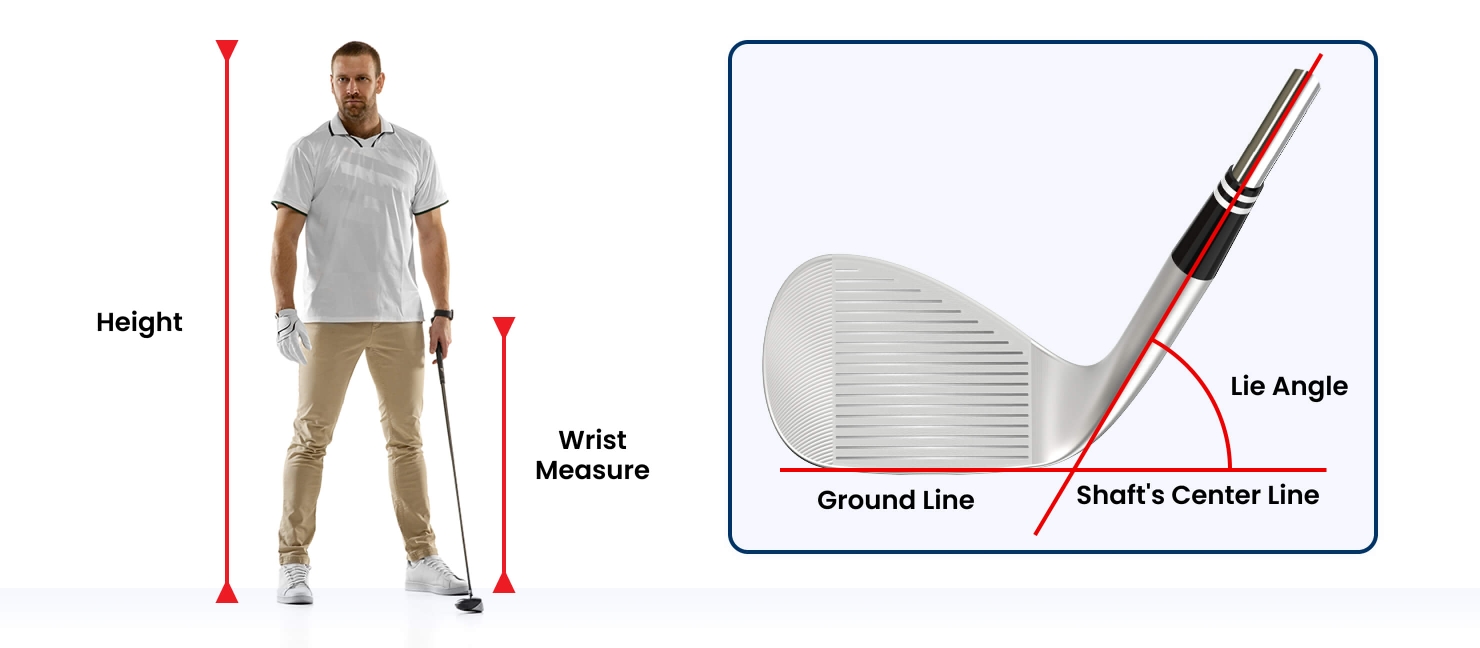How to Buy Golf Clubs for Beginners: A Complete Guide

Seasoned putters and beginners alike feel that familiar pang to invest in or upgrade their clubs! But the decision between buying a pre-assembled set or individual clubs might stop those fresh to the green from making the best decision.
In this fail-safe golf club buying guide, we cover the following to help you make the best decision:
Expert Tip:
Choose golf clubs that fit your current skill and improve your game today. Look out for lightweight options specifically designed for beginners.
Beginner Guide on Golf Clubs
When you’re first starting, don’t just grab the most expensive options on the market. There are a variety of clubs you should plan to add to your bag — each with its own unique purpose and use cases. Let’s break those down!
Per the United States Golf Association’s (USGA) rules, you can have up to 14 golf clubs in your golf club bag. Here are our recommendations:
Expert Tip:
Did you know the USGA leaves it up to you (the individual player) to choose which clubs you use? Unless you have very specific goals already lined up, it’s best to stock up your bag with a well-rounded assortment of clubs.

Here’s a breakdown of the anatomy of a golf club:
-
Grip: Located at the very top of the club, this part is held by the player as they swing.
-
Shaft: This part connects the grip to the hosel and comes in a variety of stiffness (also known as flex) and length options to match a player’s needs and preferences.
-
Hosel: Also known as the neck or socket, the hosel is the hollow section that connects the clubhead to the shaft.
-
Clubhead: Located at the very bottom of the club, the clubhead is the only part meant to make contact with the golf ball or ground.
Clubhead
Clubhead size, lie (which we explore in more detail further in this guide), and loft significantly affect how a ball behaves after it is hit by the club. Loft is the angle formed by the face of the clubhead and the ground when the clubhead is resting flat against it. It influences how far and high into the air the ball travels once hit.
-
Choosing a club with a higher loft means that the ball will pop higher up into the air when hit.
-
A club with a lower loft will arc the ball into the air less or not at all.
| Common Golf Club Shaft Materials | |||||
|---|---|---|---|---|---|
| Criteria | Steel Shaft | Graphite Shaft | |||
| Affordability | More affordable | More expensive | |||
| Weight | Heavier in weight | Lighter in weight | |||
| Ease of Swing | Easy to swing | Easier to swing | |||
| Flex Capabilities | Good flex | Better flex | |||
| Durability | More durable | Durable | |||
| Our Recommendation | Best overall for beginner golfers | Best overall for more experienced golfers | |||
| Club Type | |||||
|---|---|---|---|---|---|
| Club Type | Shaft Length (in Inches) | Loft | Average Distance | ||
| Drivers | 45-46” | 9-13 deg | 250+ yards | ||
| Fairway Woods |
3-wood (42-43”)
5-wood (41-42”)
7-wood (40-41”)
|
3-wood (15 deg)
5-wood (20-22 deg)
7-wood (21 deg)
|
180-250 yards | ||
| Irons |
5-iron (37-37.5”)
7-iron (37-37.5”)
9-iron (34.35.5”)
|
5-irons (26-28 deg)
7-iron (34 deg)
9-iron (41 deg)
|
100-200 yards | ||
| Hybrids | Hybrid lengths are typically about 0.75 inches shorter than their iron club equivalents | 14-28 deg | 160-190 yards | ||
| Wedges |
Pitching (35-36”)
Lob (35”)
Sand (35-35.5”)
Gap (35-36”)
|
Pitching (44-48 deg)
Lob (58-63 deg)
Sand (54-57 deg)
Gap (50-52 deg)
|
Pitching (80-110 yards)
Lob (50-80 yards)
Sand (60-90 yards)
Gap (90-120 yards)
|
||
| Putters | 32-36” | 2-4 deg | Not meant for hitting long distances, as it can knock the lie and loft out of alignment | ||
| We abbreviated degrees to ‘deg’ | |||||
Drivers
Also known as the 1-wood, driver golf clubs have the largest clubhead — including the largest hitting surface or face — and longest shaft of any other golf club. Drivers launch the ball at the greatest possible distance. Golfers use them for the initial shot on a par 4 or par 5.
Fairway Woods
Fairway Woods clubs can launch the ball farther without sacrificing accuracy. For this reason, golfers use this club for the initial shot on a tricky par 4 or par 5. The most commonly-used Fairway Woods are 3-woods and 5-woods.
Iron golf clubs are best-suited to a beginner’s skill level. The larger hitting surface on the clubhead gives the best chance of making solid contact with the ball. The most common choices for beginners are the following irons:
- 5-irons
- 7-irons
- 9-irons
Expert Tip:
As the iron number increases, the distance it will drive decreases.
A great choice for tee or approach shots, Hybrid golf clubs are significantly easier to use than long irons because they typically travel farther distances. They’re so versatile for beginners because they:
- Sport easier-to-hit, wood-like clubheads
- Have longer length Have greater
- loft than you’d get from an iron
Wedge golf clubs are primarily used when you need the most accuracy to hit your target. You can also use these when you’re near the green since they hit shorter distances than iron clubs. Overall, there are four types of wedge clubs you might consider adding to your bag:
- Pitching Wedge: Used to hit longer shots when height and spin are not needed.
- Sand Wedge: Used to hit the ball out of the sand or other surfaces without digging into the surface below.
- Lob Wedge: Used to launch the ball up into the air over course hazards, or send it to a more precise location without as much risk of rolling.
- Gap Wedge: Used when you feel like you need more ball-striking power than your sand wedge provides, but not quite as much power as your pitching wedge.
Expert Tip:
For complete beginners, we recommend carrying a pitching wedge and a sand wedge.
Used to hit the ball into the hole once you’ve reached the green, use either variant of this golf club when you need to make short and precise shots:
- Blade Putter: The blade putter is the most commonly used type of putter, but its thin, blade-like clubhead can be difficult for some beginners to hit.
- Mallet Putter: The mallet putter, with its heavier and much larger clubhead (for more ball-striking surface and increased alignment forgiveness), is a top choice among beginners.
Expert Tip:
Golfers often consider putter clubs to be the most important in their collection.
We’ve simplified our guide to help you get on the course faster with confidence!
Best Option: Buy Club Sets
Purchasing your first clubs in a complete set is the most economical choice for first-time golf club buyers. Aside from the cost-savings, here are the advantages of sets for beginners:
- Buying a complete set means fewer decisions, which is very helpful when you’re just starting out and trying to learn how to buy golf clubs that suit your individual needs.
- Club sets are available in many player-specific versions to accommodate a wide variety of individuals: Juniors, ladies, seniors, and left-handers.
- All of the clubs in your specific set will have a similar style and feel — ensuring that every club in your bag is designed to fit your individual needs.
- If you decide later on that you want to add something specific, you can always upgrade or add to your club collection as your skills and preferences develop at your own pace.
Alternative Option: Buy Golf Clubs Individually
While sets are our official recommendation for first-time golfers, not all putters may want a complete set. There are many advantages to purchasing individual golf clubs for the right player:
- Personalizing your club collection based on your specific needs and preferences can help improve your overall experience — and your score.
- Buying clubs one by one allows you significant customization freedom. For example, there may be a specific brand of driver clubs that you prefer, while you may like another brand’s irons or wedges.
- Purchasing your clubs individually allows you to mix and match as you desire.
- As you move out of the beginner stage and into more novice to advanced territory, you will become more familiar with your strengths and weaknesses.

No matter if you buy a set or individual clubs, any club you add to your collection needs to be correctly fitted to your individual size and height. When determining your club size, here are four main things you need to consider:
- Club length: How long the shaft of your club should be (relative to your height) in order to give you the most ideal swing
- Lie angle: How many degrees you need between your clubface and the ground (based on your stance and posture) in order to hit the ball in a straight trajectory
- Swing weight: How heavy a club should feel in your hands, in order to experience ideal performance
- Flex: How flexible or stiff your club shaft is (relative to your swing speed) in order to give you the best swing
Expert Tip:
Grip thickness also matters! Achieve the perfect grip by cradling it into the palms of your hands. Your fingers should not overlap with your thumb. Neither should it touch too much.
Club Length
To get a clear idea of the best measurement for your clubs, here is an overview of the ideal club length relative to your height:
| Club Length Overview | |||||
|---|---|---|---|---|---|
| Height (Feet/Inches) | Club Length Adjustment | ||||
| 6’8”+ | Add 2” | ||||
| 6’6” - 6’8” | Add 1.5” | ||||
| 6’4” - 6’6” | Add 11 | ||||
| 6’2” - 6’4” | Add 0.5” | ||||
| 6’1” - 6’2” | Add 0.25” | ||||
| 5’7” - 6’1” | Standard (no adjustment) | ||||
| 5’4” - 5’7” | Subtract 0.25” | ||||
| 5’2” - 5’4” | Subtract 0.5” | ||||
| 5’0” - 5’2” | Subtract 1” | ||||
| 4’10” - 5’0” | Subtract 1.5” | ||||
| <4’10” | Subtract 2” | ||||
Paying attention to your club’s length is essential. If it’s too short, you risk hurting your posture in order to hit the ball. But when it’s too long, you’ll have problems following through on your swing once you hit. You may also make more contact with the ground than the ball itself.
These two steps can help you measure your clubs’ length:
- Step 1: Standing in a normal upright position with socks and shoes on, have a family member or friend measure your overall height.
- Step 2: Refer to the table above for how your overall height should influence your club length.
Expert Tip:
5’7” - 6’1” is the height considered for standard club length.
Lie Angle
In general, the lie refers to the angle formed by the line of the shaft that meets the line of the clubhead as it is resting flatly on the ground. It can range anywhere from zero to ninety degrees and varies depending on the type and purpose of each club.

To determine your ideal lie angle, you’ll need to know your overall height and your wrist-to-floor measurement using the same instructions in the previous section above, and refer to the chart below:
| Lie Angle Overview | |||||
|---|---|---|---|---|---|
| Wrist-to-Floor Measurement | Height 4’10”-5’6” | Height 5’6”-6’2” | Height 6’2”-6’7” | ||
| 40” | N/A | 3 Upright | 3 Upright | ||
| 39” | 3 Upright | 3 Upright | 2 Upright | ||
| 38” | 2 Upright | 2 Upright | 2 Upright | ||
| 37” | 2 Upright | 2 Upright | 1 Upright | ||
| 36” | 1 Upright | 1 Upright | Standard | ||
| 35” | Standard | Standard | Standard | ||
| 34” | Standard | Standard | Standard | ||
| 33” | Standard | Standard | Standard | ||
| 32” | Standard | 1 Flat | 1 Flat | ||
| 31” | 1 Flat | 2 Flat | 2 Flat | ||
| 30” | 2 Flat | 2 Flat | 2 Flat | ||
| 29” | 3 Flat | 3 Flat | N/A | ||
Understanding What Affects Your Swing
- Players with shorter forearms: You’ll likely need to hold your clubs in a more flat position in order to hit the ball straight.
- Players with longer forearms: You’ll likely need to hold your clubs more upright in order to hit the ball straight.
Flex
Flex is the club shaft’s bending ability when you swing and apply force to it. Having the wrong flex level for your swing can cause your shot to follow an unpredictable trajectory. In order to determine which flex level is right for you, take a look at the distance you generally hit from your driver:
- Extra Stiff: Typically only used by professionals
- Stiff: 250+ yards
- Regular: 230-250 yards
- Senior: 200-230 yards
- Ladies: Fewer than 200 yards
Whatever the reason, upgrading your clubs will eventually be inevitable for every beginner golfer. Whenever you’re ready to take the jump, here are our best tips:
- Know your measurements: Knowing your ideal club length, lie angle, swing weight, and flex will make shopping for new clubs so much easier. If you’re ready to move beyond static measurements for a more customized fit, consider getting professionally fitted.
- Have an idea of which clubs you want to replace: Knowing your priorities can help you budget for new clubs while making sure you get the ones that will most directly improve your game.
- Do your research: Golf clubs aren’t really something you should invest in on a whim. Going into a purchase decision with an idea of which brands and styles you prefer will help you feel more satisfied and confident with your decision!
Next Steps
Buying your first set of golf clubs can be both exciting and intimidating. But with this comprehensive beginner’s guide, we hope you feel confident in taking this first step into your golf career.
Ready to get out onto the course? Head over to the Academy Golf Shop, which features a vast selection of complete sets and individual clubs to suit your needs.